Medical Receptionist Resume Example & Writing Tips 2024
The Centers for Disease Control (CDC) estimated in 2016 that there were 883 million medical office visits by patients in the United States. While many doctor offices have online patient scheduling portals on their websites, it's still quite common for patients to call their doctors to schedule appointments or request pharmaceutical refills. On the other end of those calls are friendly receptionists. However, before being hired, they all wrote a medical receptionist resume that likely helped them get that job.
A medical receptionist job description resume is a supporting document that accompanies an application or is published on online job search websites. The intent of the front desk medical receptionist resume is to provide additional substance about a candidate's qualifications, experience, and skills. An excellent medical secretary resume is typically a single page in length and will document the applicant's work history, contact information, education, references, and related skills.
Writing a medical front desk receptionist resume can be challenging for many applicants who have never attempted to create one. However, if you stick to a proven process, use helpful tools, and spend time carefully editing the content, it's not as tricky as you'd imagine. This is what we will explore in the information below.
This article will provide some easy-to-follow tips for writing an experienced or entry level medical receptionist resume. We will explain why it's crucial to draft a powerful medical receptionist resume objective and how to select the proper work history, skills, references, and education. Finally, we'll provide you with a few medical receptionist resume examples to review – and explain how to outline each section.
Let's get started if you're ready to learn how to write an attention-getting medical office receptionist resume.
Medical Receptionist Resume Sample
Medical offices range from a small independent practice to extensive, high volume, multiple specialist facilities. Due to this diversity, the job of a medical receptionist can vary significantly. Some are asked to simply check in patients and answer phone calls, complete light medical billing, compile patient medical records – or even complete minor medical assessments. Due to this diversity, applicants should carefully read any job posting before submitting their applications and medical receptionist resume.
A job posting – whether published on a job search engine or at the medical office itself- will explain the required skills, work experience, and certifications for the candidate to possess. Sometimes the posting will also include interpersonal skills that the medical office staff is searching for with the ideal candidate. This information is crucial to know before compiling data and formatting your medical receptionist front desk resume.
As a receptionist applicant, your ability to pay attention to details is a critical skill. You'll have an opportunity to prove this when you start with your resume in the contact information section. Offices in the healthcare industry are highly secure facilities, as they provide their doctors and specialists with private patient information.
As you begin your job search for positions in this industry, you'll have to consider HIPAA (Health Insurance Portability and Accountability Act) regulations that all employees must follow. A hiring manager will ask you about this during an interview - just to give you a heads up.
Our professional resume writers have drafted this sample resume for medical receptionist positions to give you an idea of how a great resume should appear. This is a resume for our mythical candidate Jessica Jackson – who is applying for a front desk position at a pediatric medical office in her hometown of Denver, Colorado.
Take time to review each section of this medical receptionist resume sample, paying close attention to how it's structured and formatted and some clever language used to describe her skills and abilities.
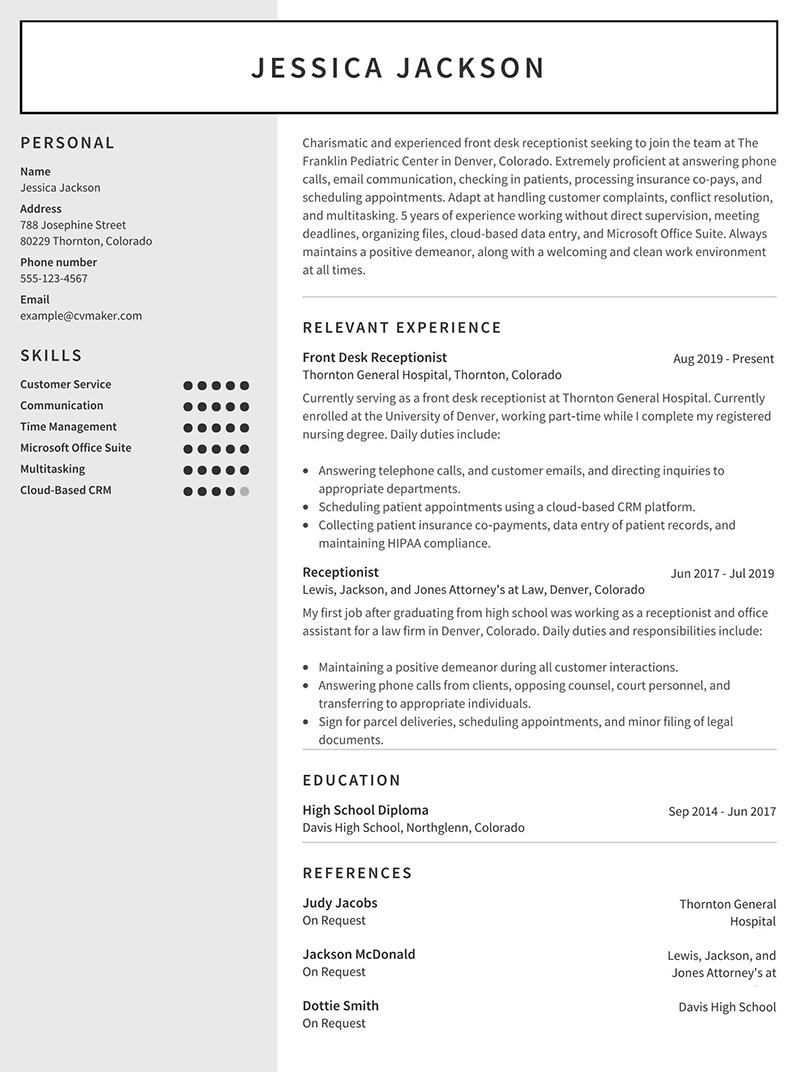
Sometimes to stand out among the competition of other qualified candidates, you'll have to go above and beyond to customize your resume. That's what Jessica accomplishes in the first sentence of her resume objective section. She has written this resume specifically to the pediatrician's office in Denver.
As you review the entire medical receptionist resume, you'll notice that she has listed a work history section (with two previous jobs), her education, three excellent references, and her top skills relevant to this job.
The resume format is clean, organized, and easy to read. It is designed to support her application – which we'll assume was submitted through an online job posting website. These platforms typically use automated software solutions to search for keywords or action verbs relevant to a specific career. You'll notice words like compassionate, charismatic, organized, professional, articulate, and attention to detail sprinkled throughout her resume.
How to Write a Good Resume for Medical Receptionist in 2024: Full Guide to Front Desk Medical Receptionist Resumes
The sample medical front desk resume above is a professional example of what most office managers and hiring firms are looking for with the perfect candidates. While the substance within the resume (such as relevant work history, education, and skills) is vital, how the candidate articulates this experience also matters.
If you've reviewed the resume and are thinking, "there is no way I can come up with something this good," don't worry about it. In fact, we believe that if you start with a plan and follow these tips below, your medical receptionist resume sample will look just as good as ours.
Here is a proven plan that helps anyone – regardless of their writing skills, organize and outline the content of their resume, so you can use some technology tools to edit and format it to look like ours.
Step 1: Create a Master Resume
A master resume is nothing more than a word document that allows you to create an outline. The purpose of this document is for you to define the primary sections, add content for each, and edit the content. You can use Apple or Word documents, as you'll complete the final editing in an online grammar software solution – such as Grammarly.com.
Step 2: Add Your Supporting Content
Once you create the primary sections (which we'll introduce below), you'll add supporting content for each primary section. For example, in Jessica's resume, you'll notice she has written her personal contact information, a four-sentence resume summary, added two previous jobs (bullet points of key accomplishments or tasks), her highest level of education, three references, and six important jobs skills. That's it.
Step 3: Edit the Content
While Microsoft Word or Apple Pages are great word processing programs, they lack some basic grammatical editing tools. We recommend an online platform called Grammarly.com to edit your resume from top to bottom.
Step 4: Use a High-Quality Resume Builder or Template
When your document is grammatically perfect, it's time to create the layout. Using a great online resume builder like ours here at CVMaker.com makes formatting the resume simple. Our online template allows you to add personal information, customize primary sections and paste the content into subsections. In the end, the finished product is organized, easy to read, and professional.
Now that we've provided you with the secrets to our success let's break down the primary sections you should add to the dental receptionist resume.
Personal Contact Information: List your full legal name, mailing address, email, and mobile phone number. That's it. There is no need to add your social media pages.
Resume Summary: The resume summary is next on medical office resumes. It's your short opportunity to explain why you're an ideal candidate for the receptionist or front desk position.
Work History: This is where you'll add the relevant work experience section. Pick two recent jobs where you've completed similar tasks that your future employer will assign you. This showcases your ability to start the patient care job successfully without needing much training.
Education: You'll add the highest level of education in this section. No need to list your current educational enrollment. If you prefer, add this information to a cover letter or resume objective.
Skills: We recommend picking your top six hard or soft skills that are important for a receptionist or front desk position. We'll provide some samples in the sections below.
References: With a medical receptionist office position, selecting three references to list on your resume is best. We'll explain how to format this in your resume – so you can protect their private information.
Start your master resume by adding the document's primary sections in bold type. As we outline each section, you can add relevant details to each – so you save some time.
Let's start working on your resume.
Section #1 – List Your Contact Information
We'll keep the information in these sections simple – and have you refer to our cut-out sections posted in each to give you an example of how it should appear. For your medical receptionist resume, you should only include your full legal name, mailing address, email, and mobile phone number.
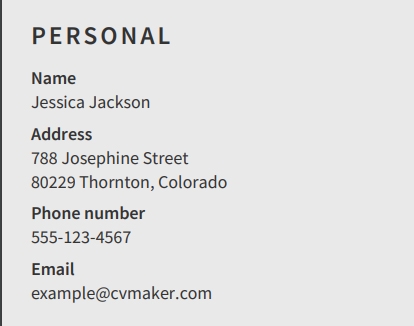
The most important item to remember is to match what you've listed on your application and cover letter. This shows consistency and attention to detail – two crucial elements and traits that all medical office candidates must possess.
How to Format this Section
When using the master resume, write each item listed above separately. This will make it easier for you to copy and paste into a resume builder or template – such as the one we used to create the sample resume above.
Section #2 – Resume Summary
Many job candidates struggle with overthinking the content in the resume summary. They'll get caught up in coming up with the perfect action verbs and adjectives to describe their skills and candidacy. The key to writing a smooth resume summary is to keep it conversational.
The resume summary section is your opportunity to introduce the years of experience, abilities, and interpersonal skills that make you a great medical receptionist. It should be a 150 or so word elevator pitch. The resume summary explains your desire to join the company quickly, your skills and experience, and what separates you from other candidates.
With a medical receptionist position, focus on your interpersonal skills, such as being a strong communicator, charismatic, processing insurance information, paying attention to detail, working with a medical assistant on different tasks, able to work unsupervised, and able to handle conflict. An excellent medical office receptionist needs to be great at handling customer objections, problem-solving, and conflict resolution.
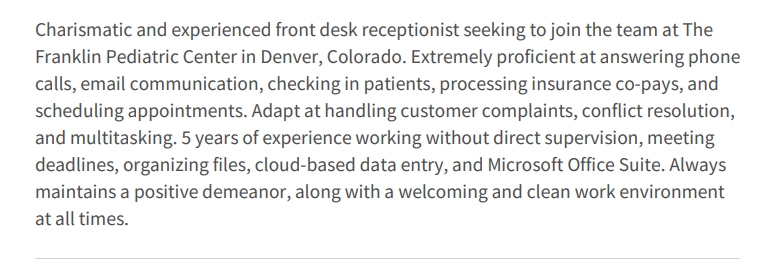
When you review the resume summary in Jessica's submission, you'll notice that she's listed the hard and soft skills that will make her a great receptionist. Finally – she wraps up the paragraph by talking about her interpersonal skills – including teamwork, compassion, and working well with children. This is specific to her application for work at the pediatric office.
How to Format this Section
We recommend using the word document master resume because you can have the program dictate it to you to hear how it sounds. Limit the resume summary to 125 to 150 words. When you format it – this section needs to be listed directly under your contact information or at the top of the page – either directly under your contact information or next to it (like you can see in Jessica's sample resume.)
Section #3 – Work History
You need to list relevant work history in a resume. We strongly recommend writing multiple versions of the same general resume – but targeted for specific industries or applications. This is what our candidate Jessica has done – specifically with the work history section.
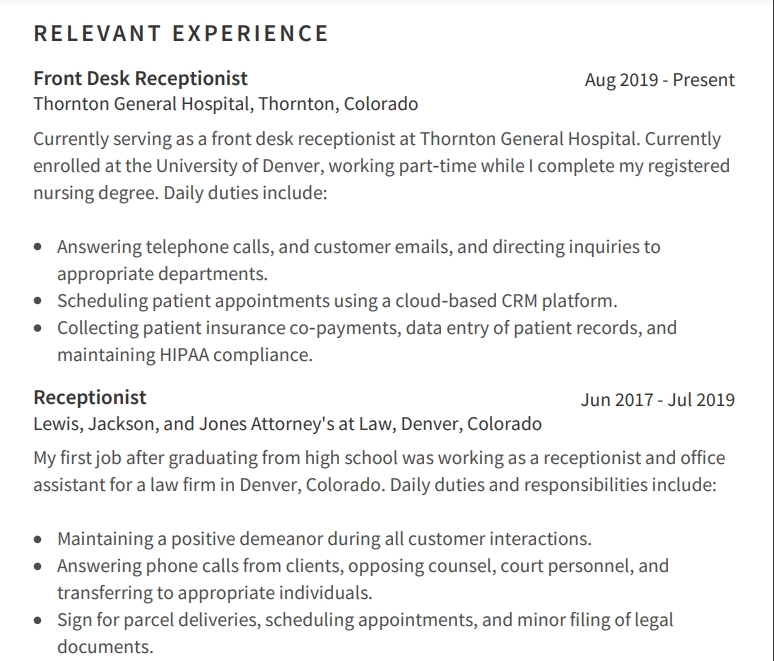
You'll notice in her work history section that she's selected two previous positions. The first is her current position as a front desk representative at a hospital in her hometown of Thornton, Colorado. In her hospital receptionist resume she has listed the details about the job, but also three key bullet points of typical duties. The second is a previous receptionist position for a law firm. While it's not related to the medical field, it is specific to the job she hopes to retain.
How to Format this Section
The work history section should include (2) examples of jobs or places you've worked. For the formatting, list the business's name, location, dates of employment, and a few bullet points of your responsibilities. You'll want to record these jobs in reverse chronological order – or list the recent positions on top and follow in order of the day you left the previous employment.
Section #4 – Education
You'll find the educational requirements posted in a job posting description. Most receptionist jobs require the candidate to have a high school diploma or GED certificate (in some cases). When listing education on your resume, the critical item to focus on is only documenting your highest completed level.

Like other examples of medical receptionist resumes, you'll notice that Jessica has listed her high school diploma. She could post this in her resume summary if she was currently enrolled in college. However, we believe this information is best listed in a cover letter to introduce your candidacy.
How to Format This Section
Formatting the education section is very easy. Just list the name of the school, its location, dates, and the degree earned.
Section #5– References
A job reference is typically a formality for most employment positions. In fact, it's not very common for employers to contact references. Instead, they will complete background checks, including credit references depending on the position. However, selecting quality references who will vouch for your credibility, work ethic, and experience is essential.
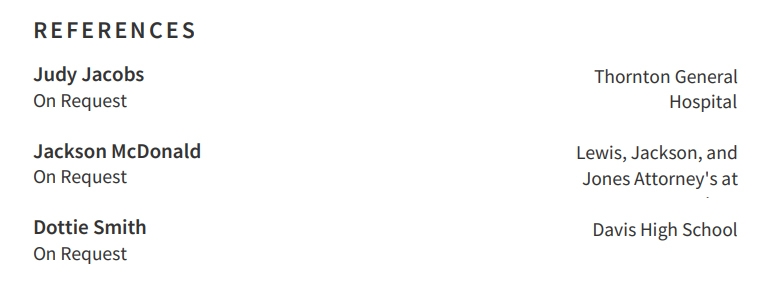
We recommend using three total references for a receptionist position at a medical office. Select (2) references you've worked with – either in school, a previous job, or a volunteer position. This would serve as a professional mentor. The final reference should be a personal one – or a family friend or mentor who can speak to your personality and credibility.
How to Format This Section
Your references trust you with their private information. As such, keeping their contact information away from your resume is essential. We strongly recommend listing their name, where you know them from (or the employer), and the term "Upon Request." If a medical office wishes to contact your references, you can provide their personal details directly to the office.
Section #6 – Skills
The best receptionist has great communication skills, is engaging and charismatic people on the phone, greet them in person, are great with multitasking, data entry, processing co-payments, understand medical terminology, and are very detail oriented. Since you'll likely have access to patient records, it's also essential to maintain confidentiality, have a strong work ethic, and have excellent computer skills.
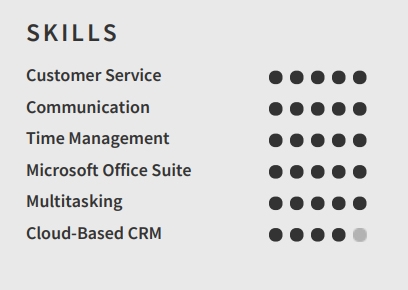
These are a few of the skills that Jessica has listed on her medical receptionist resume sample above. She also mentioned having technology skills such as using Microsoft Office Suite – and Cloud-based CRMs – tools often used in a medical office environment in the skills section.
How to Format This Section
List the skills you possess requested by the future employer in a bullet point format in your master resume. From that point, you can add them to a template – making them easy to access for future employers and hiring agencies.
Other Front Desk Resume Templates
We hope that the information we've compiled above gives you a clear path to structure, organize and write a powerful medical office receptionist resume. However, reviewing similar positions will sometimes help you gather critical insights and tips you can infuse into your own.
We have assembled a collection of other administrative support or front desk resume templates, which are 100 percent free to review. Take some time to read the sample resumes – and feel free to incorporate some of the ideas in these resumes into yours.
Receptionist Resume (link to article once it's ready)
Dental Receptionist Resume (link to article once it's ready)
Veterinary Receptionist Resume (link to article once it's ready)
Final Points on Writing a Medical Front Desk Receptionist Resume
Writing the perfect resume is an unattainable goal. You can be the best writer in the world, creating thousands of resumes and still struggling to find the perfect words for the best resume. However, you don't need to be perfect with your front office resume. If there are a few things you should focus on, it should be spelling everything correctly, being grammatically accurate, and making sure the finished resume flows from start to finish.
For a quick recap, here are some specific tips to remember.
- Make sure the resume reads and flows easily.
- Always write your resume on a plain white background with black font.
- Edit the document SEVERAL TIMES – through Grammarly.com and visual inspection.
- Ensure its well-spaced, organized, and professional.
- Finally, read it aloud a few times before you're ready to paste the content into a resume builder or template.
Suppose you stick to following the structure, layout, and some of the significant sections we recommend for this medical receptionist resume. In that case, you'll have a better shot of getting that all-important interview and landing that perfect job.